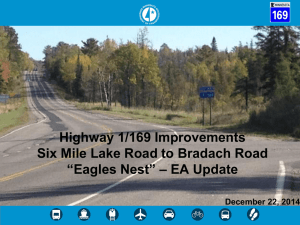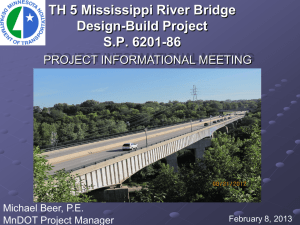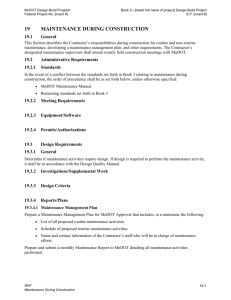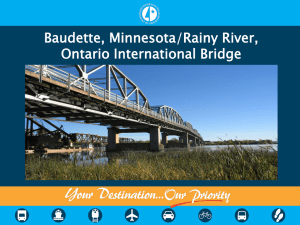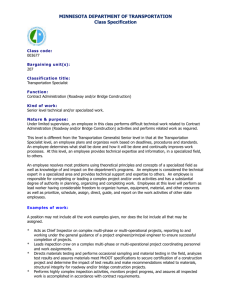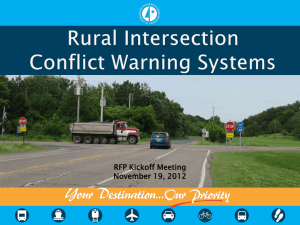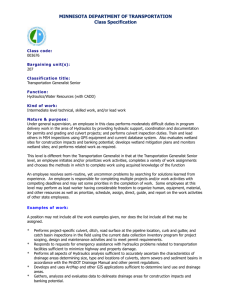Section 15 Visual Quality
advertisement
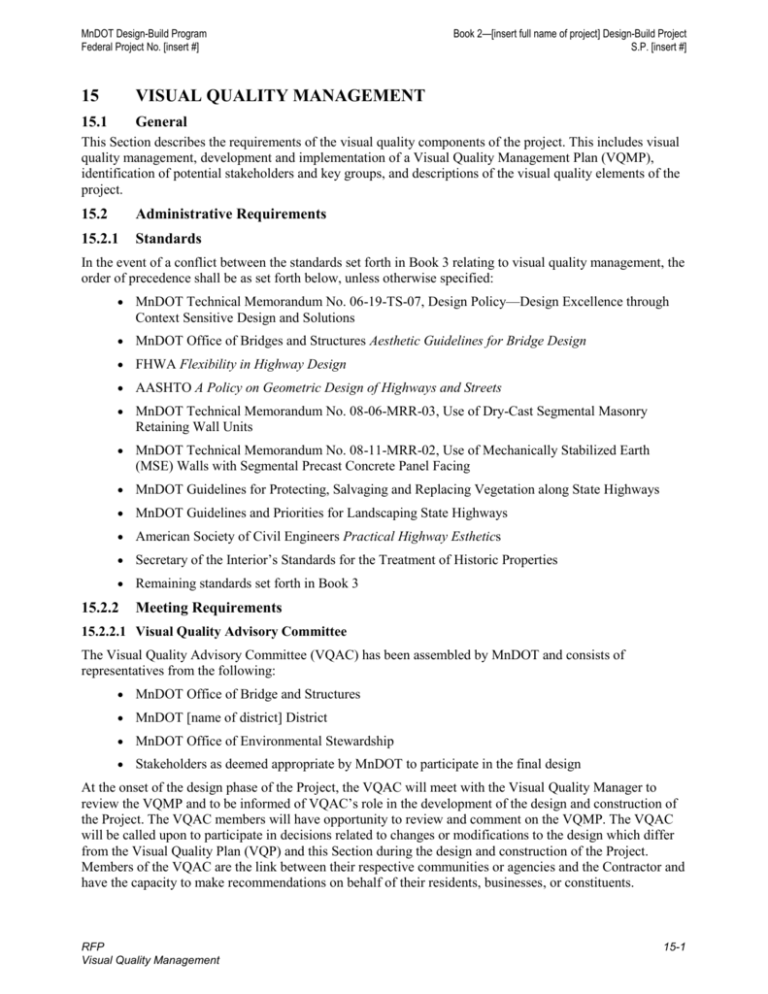
MnDOT Design-Build Program Federal Project No. [insert #] 15 VISUAL QUALITY MANAGEMENT 15.1 General Book 2—[insert full name of project] Design-Build Project S.P. [insert #] This Section describes the requirements of the visual quality components of the project. This includes visual quality management, development and implementation of a Visual Quality Management Plan (VQMP), identification of potential stakeholders and key groups, and descriptions of the visual quality elements of the project. 15.2 Administrative Requirements 15.2.1 Standards In the event of a conflict between the standards set forth in Book 3 relating to visual quality management, the order of precedence shall be as set forth below, unless otherwise specified: MnDOT Technical Memorandum No. 06-19-TS-07, Design Policy—Design Excellence through Context Sensitive Design and Solutions MnDOT Office of Bridges and Structures Aesthetic Guidelines for Bridge Design FHWA Flexibility in Highway Design AASHTO A Policy on Geometric Design of Highways and Streets MnDOT Technical Memorandum No. 08-06-MRR-03, Use of Dry-Cast Segmental Masonry Retaining Wall Units MnDOT Technical Memorandum No. 08-11-MRR-02, Use of Mechanically Stabilized Earth (MSE) Walls with Segmental Precast Concrete Panel Facing MnDOT Guidelines for Protecting, Salvaging and Replacing Vegetation along State Highways MnDOT Guidelines and Priorities for Landscaping State Highways American Society of Civil Engineers Practical Highway Esthetics Secretary of the Interior’s Standards for the Treatment of Historic Properties Remaining standards set forth in Book 3 15.2.2 Meeting Requirements 15.2.2.1 Visual Quality Advisory Committee The Visual Quality Advisory Committee (VQAC) has been assembled by MnDOT and consists of representatives from the following: MnDOT Office of Bridge and Structures MnDOT [name of district] District MnDOT Office of Environmental Stewardship Stakeholders as deemed appropriate by MnDOT to participate in the final design At the onset of the design phase of the Project, the VQAC will meet with the Visual Quality Manager to review the VQMP and to be informed of VQAC’s role in the development of the design and construction of the Project. The VQAC members will have opportunity to review and comment on the VQMP. The VQAC will be called upon to participate in decisions related to changes or modifications to the design which differ from the Visual Quality Plan (VQP) and this Section during the design and construction of the Project. Members of the VQAC are the link between their respective communities or agencies and the Contractor and have the capacity to make recommendations on behalf of their residents, businesses, or constituents. RFP Visual Quality Management 15-1 MnDOT Design-Build Program Federal Project No. [insert #] 15.2.3 Equipment/Software 15.2.4 Permits/Authorizations 15.3 Design Requirements 15.3.1 General Book 2—[insert full name of project] Design-Build Project S.P. [insert #] This section includes the design requirements for Visual Quality Elements (those elements that typically affect the appearance of highway transportation projects), including, but not limited to, bicycle and pedestrian facilities, grading, retaining structures, slope protection, bridges, culverts, traffic barriers, signing, lighting, noise walls, and fencing. 15.3.2 Investigations/Supplemental Work 15.3.3 Design Criteria 15.3.3.1 Visual Quality Details Request for Construction (RFC) Documents shall include Visual Quality Details specifying forms, sizes, patterns, textures, colors, finishes, and all other visual quality components or elements in the Project as included in the VQP. 15.3.3.2 Visual Quality Elements The following design requirements pertain to those elements that typically affect the visual quality of highway transportation projects, herein referred to as visual quality elements. The design requirements define the basic visual quality objectives that will be integrated into the VQP and the development of the Project. Develop designs for and build all elements of the Project in compliance with the visual quality requirements illustrated in this Section. Design and build a Project that responds to the Project’s context and develops design solutions that maintain or enhance existing visual quality, so that all design solutions create visual harmony with the natural environment, visual order with the community setting, and design coherence within the highway corridor. Coordinate the architectural character and treatments used for all elements within the Project so that a consistent architectural vision or family of complementary features is used throughout the Project corridor. 15.3.3.2.1 Bridges This section applies to all engineered structures constructed as part of the Project that include a superstructure resting on a substructure and carry vehicular, bicycle, or pedestrian traffic. All spans in a particular bridge shall have a constant superstructure depth. For steel girder bridges and non-curved prestressed concrete beam bridges, provide fascia overhangs that maintain a constant dimension for the entire length of the bridge. 15.3.3.2.2 Retaining Structures This section applies to any structure that is engineered to hold earth in a position steeper than a natural angle of repose. Include retaining wall locations, alignment, elevation construction type, surface texture, finish, and color in the project VQP and implement via the VQMP. To the extent practicable, limit the use of retaining structures to only those areas where such structures reduce adverse impacts to natural or cultural environmental assets or otherwise would require additional right of way. RFP Visual Quality Management 15-2 MnDOT Design-Build Program Federal Project No. [insert #] Book 2—[insert full name of project] Design-Build Project S.P. [insert #] Design retaining structures with jointing that matches the simulated coursing or jointing of any surface rustication or architectural treatment. 15.3.3.2.3 Noise Walls This section applies to all constructed or installed elements meant to reduce the ability of sensitive receptors (as defined by federal and State regulations) to hear sounds generated by traffic moving on the proposed highway. Design the noise wall and construct to appear as illustrated in Exhibit 15-D. Prepare sufficient illustrations to fully communicate the visual character of the proposed noise wall, including elevations, material designation, textures, and colors for all components of the wall for inclusion in the VQP. During the VQP preparation, present the design to the VQAC for evaluation and approval. For finish of newly constructed noise walls, follow the manufacturer’s recommendations for surface preparation and application and MnDOT’s guidance regarding approved products and procedures. The final noise wall design documents shall define those elements which shall be constructed as a mock-up for Approval by MnDOT. 15.3.3.2.4 Traffic Barriers This section applies to all constructed devices used to redirect errant vehicles away from obstacles, including steep embankments, bridge piers and abutments, sign structures, trees, and other immovable objects. It also includes devices used to separate modes of transportation, such as motorized vehicles from pedestrians or buses from automobiles. Traffic barriers may also separate different directions of travel. Curbs are not considered traffic barriers. [xxxxx] [xxxxx] 15.3.3.2.5 Signing This section applies to all signs installed on right of way as part of the Project and maintained by MnDOT or other governmental agencies and includes regulatory, advisory, directional, service, logo, and attraction signs. Do not mount signs on bridges unless replacing existing signs that were already placed on the structure. Use uniform sign panel heights when sign placement requires that more than one sign panel be located on a signing structure when possible. If multiple signs or sign structures are required to be mounted on the bridge(s), use signs that have the same vertical dimensions and mount them at the same elevation when possible. When mounting signs on bridge(s) to service motorists passing under the bridge(s) is required, attach the signs in an unobtrusive manner. Do not extend the top of the signs above the top of concrete portion of the bridge rail and do not extend the bottom of the sign below the bottom of the outside girder. 15.3.3.2.6 Pedestrian Railings Design and construct pedestrian railing for Bridge [bridge identification] and for other site locations, as required, as shown in Exhibit 15-B. Design and construct pedestrian railing for trail facilities railings as shown in Exhibit 15-C. All pedestrian railings shall be painted with similar color. RFP Visual Quality Management 15-3 MnDOT Design-Build Program Federal Project No. [insert #] 15.3.3.2.7 Book 2—[insert full name of project] Design-Build Project S.P. [insert #] Surface Water This section applies to any construction that results in creating, eliminating, altering, or obscuring any surface water features, including both standing and running bodies of water. Standing bodies of surface water include those commonly referred to as lakes, ponds, marshes, fens, swamps, wetlands, retention ponds, and detention ponds. Running bodies of surface water include those commonly referred to as rivers, streams, creeks, channels, canals, swales, and ditches, or other visible drainage features. 15.3.3.2.8 Slope Protection This section applies to any non-structural treatment engineered to hold earth in a position equal to or less than a natural angle of repose. Slope protection includes paving, paved berms, riprap, and any bioengineered or vegetative method of slope stabilization. To the extent practicable, avoid the use of paving, riprap, or other engineered slope protection where light and water conditions would adequately support establishment of vegetative cover that would stabilize slopes and control erosion. Provide concrete slope paving and concrete walk or geo-cell supported aggregate protection in areas where natural light and water conditions will not support vegetation, especially beneath bridges. Employ a consistent surface treatment or family of complementary surface treatments on slope protection which are compatible with the overall theme of the corridor. Provide pavement for boulevards that are less than 6 feet wide. 15.3.3.2.9 Culverts This section applies to all structures that traverse beneath a roadway, trail, driveway, or similar facility to convey something that would impede traffic if allowed to cross the road, trail, or driveway at grade. 15.3.3.2.10 Lighting, Signals, and Utilities Do not place conduits at the following locations: Outboard side of box girders Outboard side of precast concrete fascia beams External face of substructures, wingwalls or abutments 15.3.4 Reports/Plans 15.3.4.1 Visual Quality Management Develop a Visual Quality Management Plan (VQMP) defining the qualifications, responsibilities, and authority of the Visual Quality Manager. 15.3.4.1.1 Visual Quality Manager Responsibilities The Visual Quality Manager reports to the Contractor’s Project Manager and MnDOT’s Project Manager. He or she must be available to be on Site during design and construction activities involving visual quality issues. The Visual Quality Manager shall be responsible for the following: Overseeing and coordinating the requirements from the Visual Quality Plan for the project Implementing the VQMP Coordinating visual quality issues with the VQAC, MnDOT, and the Contractor’s design and construction teams Implementing the aesthetic concepts of the VQP. RFP Visual Quality Management 15-4 MnDOT Design-Build Program Federal Project No. [insert #] 15.3.4.1.2 Visual Quality Manager Authority 15.3.4.1.3 Producing the Visual Quality Management Plan Book 2—[insert full name of project] Design-Build Project S.P. [insert #] Produce a VQMP in accordance with the requirements of this Section 15. The VQMP shall define the following: The methods for coordinating and interacting with MnDOT. The methods for addressing visual quality issues. These methods will determine, define, and detail solutions for maintaining and enhancing existing visual quality. The involvement of the Visual Quality Manager and MnDOT in identifying areas or elements of the proposed bridge, roadway, and surroundings that present opportunities or concerns in the development of a visually acceptable design. The responsibilities and authority of the Visual Quality Manager in reviewing the overall project, design details, full-scale mock-ups, samples, and other submittals relating to the development of a visually acceptable design. The authority of the Visual Quality Manager and the process for which he or she will coordinate the input from MnDOT and the VQAC with the Contractor’s design and construction teams. The process for maintaining the record of visual quality recommendations and decisions throughout the Project. The distribution of the product, including who shall receive the VQMP. Distribution shall include, at a minimum, Contractor’s personnel, MnDOT, and the VQAC. A list of VQAC members (provided by MnDOT), their contact information, and a plan or process for interacting with them. 15.3.4.2 Visual Quality Plan Comply with this Section when developing the VQP and RFC documents for the Project. Detail the architectural aspects for the bridges, retaining structures, and other aesthetic features used on the Project, including shape and form of structural elements, patterns, textures, colors, finishes, and other visual features in conformance with this Section. Obtain approval for any items not covered in this Section or the VQP that the Contractor intends to include in the design. Approval of all such elements is required and then become part of the approved VQP for the project. 15.3.4.2.1 Producing the Visual Quality Plan Produce a VQP as follows and in accordance with the requirements of this Section. The preparation of a VQP shall include descriptive narrative and graphic exhibits thoroughly illustrating all aesthetic details to be used on the project. The VQP shall be comprehensive and include color palette, texture, details, such as plans, elevations, sections, and perspective sketches of all aesthetic details of elements to be included the Project. For more detailed submission requirements, see Section 15.5 Deliverables below. 15.4 Construction Requirements 15.4.1 General 15.4.2 Construction Criteria RFP Visual Quality Management 15-5 MnDOT Design-Build Program Federal Project No. [insert #] 15.4.3 Book 2—[insert full name of project] Design-Build Project S.P. [insert #] Materials/Testing Requirements Provide mock-ups or samples for the items described in this Section. Mock-ups or samples Accepted by MnDOT shall become the reference standard(s) for the Project. The reference standard(s) shall be maintained undisturbed until Substantial Completion of the Project. 15.4.3.1 Retaining Structures Construct a minimum 4-foot by 4-foot mock-up for each type of retaining wall as indicated by the VQP for Acceptance by MnDOT. 15.4.3.2 Bridges Construct a minimum 4-foot by 4-foot mock-up for each architectural concrete texture as indicated by the VQP or proposed by the Contractor. 15.4.3.3 Noise Walls Construct an 8-foot by 8-foot mock-up of the project noise wall. 15.5 Deliverables Visual Quality Management Plan—Submit for Approval within 30 Days of Notice to Proceed 1 (NTP1). Visual Quality Plan—Within 60 Days of NTP1, submit fifteen individually bound full-color hardcopies of the VQP for all elements which are to be part of the final design. The draft VQP shall include all drawings and text necessary to conform to the requirements of Section 15.3. The Visual Quality Manager shall submit the draft VQP to the VQAC for its consent before submitting the VQP to MnDOT for Approval. Within 10 Working Days of MnDOT Approval, submit fifteen fullcolor printed copies of the Approved VQP to MnDOT. The covers of these copies shall include the words “Approved Visual Quality Plan,” the name of the Contractor, the name of the Project, and the date of MnDOT Approval. The VQP shall be in a three-ring binder with waterproof cover. The contents shall be printed on 8.5-by-11-inch bond paper or 11-by-17-inch bond paper accordionfolded to form an 8.5-by-11-inch page. In addition to the printed Approved VQP, provide MnDOT, within 10 Working Days of MnDOT Approval, ten CD copies of the Approved VQP Exhibits as PDF files. Each CD shall be supplied in a plastic re-sealable case. A printed label with “Approved Visual Quality Plan,” the name of the Project, and the date of MnDOT Approval shall be affixed to each CD. The label shall be readable through the CD case. Also provide an electronic file containing the label to MnDOT for reproduction of additional CDs. Visual Quality Mock-ups and Samples—Submit a minimum of 15 Days prior to the construction or installation of any of these elements. RFP Visual Quality Management 15-6 MnDOT Design-Build Program Federal Project No. [insert #] Book 2—[insert full name of project] Design-Build Project S.P. [insert #] EXHIBITS All exhibits are provided as electronic files. Exhibit 15–A Retaining Wall Texture Exhibit 15–B Bridge Aesthetics and Pedestrian Railing Exhibit 15–C Trail Facilities Pedestrian Railing Exhibit 15–D Noise Wall RFP Visual Quality Management 15-7
